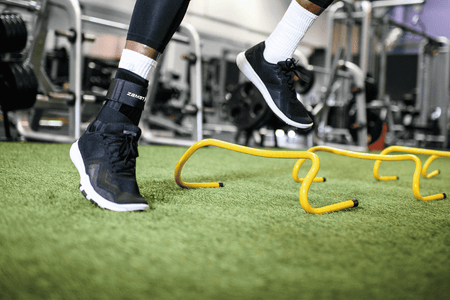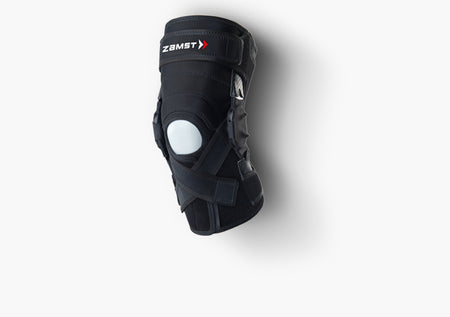
What is Jumper’s Knee?
Jumper’s knee otherwise known as “patellar tendonitis” is a knee injury that is typically caused by overuse from sports that require frequent jumping and landing. It differs from a knee sprain because it involves the tendon vs the ligaments of the knee. The patellar tendon connects the kneecap (patella) to the shinbone (tibia). The condition is characterized by inflammation of the patellar tendon causing pain and discomfort with bending and straightening your knee.
Risks factors typically include people who participate in activities that require frequent jumping, such as basketball, volleyball, and running. Many factors can play a role, such as playing surfaces, footwear and muscle imbalances.
Jumper’s knee can start with low level pain and tenderness (mild cases) to prolonged pain and discomfort that won’t go away unless treated.

Why does this happen?
Jumper’s knee, also known as patellar tendonitis, is caused by overuse of the knee joint from repetitive jumps typically on hard surfaces. Activities involving frequent jumping and rapid acceleration, or deceleration can place excessive strain on the patellar tendon which can lead to inflammation of the tendon. Over time microtears develop in the tendon causing inflammation and pain. This can reduce the knee’s ability to be a knee stabilizer. Jumper’s knee typically occurs in sports such as basketball, volleyball and track and field. This condition can develop from various factors such as:
- 1. Type of movement: Sports that require frequent jumping and landing
- 2. Muscle imbalances: Weak or tight muscles of the lower leg can alter knee mechanics
- 3. Playing surfaces: Hard or uneven playing surfaces that increase impact on the knees
- 4. Footwear: Inadequate or worn-out shoes that do not provide sufficient support or cushioning
- 5. Age: Higher risk in younger athletes due to rapid growth spurts and skeletal immaturity

What are the symptoms?
The healing time from jumper’s knee (patellar tendonitis) can vary depending on severity of the condition, the individual’s overall health, and the effectiveness of treatment. Generally, healing outcomes look like the following:
- 1. Mild cases: May heal within a few weeks given the proper treatment and healing protocol
- 2. Moderate cases: May take weeks to months depending on treatment, resting from sport or continuing to play
- 3. Severe/Chronic cases: May take several months to heal and can turn into a tendonosis (chronic condition characterized by degeneration of the tendon.
Being proactive with jumper’s knee is the key to reducing overall healing times and promoting recovery.
How Long Does it Take to Heal?
The healing time from jumper’s knee (patellar tendonitis) can vary depending on severity of the condition, the individual’s overall health, and the effectiveness of treatment. Generally, healing outcomes look like the following:
- 1. Mild cases: May heal within a few weeks given the proper treatment and healing protocol
- 2. Moderate cases: May take weeks to months depending on treatment, resting from sport or continuing to play
- 3. Severe/Chronic cases: May take several months to heal and can turn into a tendonosis (chronic condition characterized by degeneration of the tendon.
Being proactive with jumper’s knee is the key to reducing overall healing times and promoting recovery.
TREATMENT
The treatment for Jumper’s knee or patellar tendonitis typically involves a combination of approaches to alleviate pain, reduce inflammation and promote healing. Here are three common treatment types.
Rest, bracing, and activity modification
Reducing or completely stopping activities that promote the condition can be crucial especially early on. Rest will allow the tendon to go through the inflammation period and heal which will reduce further damage. Bracing options such as a strap or knee compression sleeve can reduce compression forces to the patellar tendon and provide knee support. Modifying activities to lower impact alternatives such as swimming or cycling can maintain fitness levels and act as a knee protector.

Physical Therapy
- Having a healthcare clinician such as a physical therapist perform an evaluation and create a treatment plan can significantly aid in recovery. The physical therapist will often prescribe exercises, educate on activity modification, and perform manual therapy. This can speed up the healing process with jumper’s knee.

Therapeutic Interventions
- In more persistent cases, treatment such as corticosteroid injections, platlet-rich plasma (PRP) therapy, shockwave therapy can aid in reducing pain and enhancing tissue repair.


PT, DPT, MS
Evan Jeffries
EVAN JEFFRIES is a physical therapist with a Doctorate in Physical Therapy (DPT) from the University of St. Augustine for Health Sciences. He has vast knowledge of the musculoskeletal system and has treated many orthopedic conditions by bringing a proactive approach to healthcare and lifestyle.
Brace Finder
Looking for a brace that best suits you? Dive into the Brace Finder and find the best brace for your symptom.

 Canada
Canada China
China France
France Korea
Korea
































